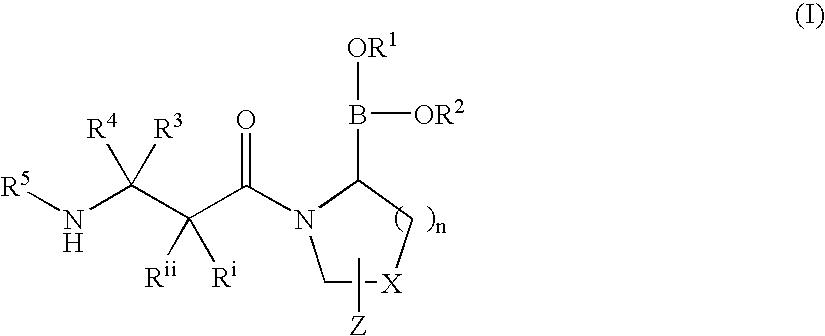Heterocyclic boronic acid compounds
a technology of heterocyclic boronic acid and compounds, which is applied in the field of boronic acid compounds, can solve the problems of increasing the risk of premature death, no convincing pharmacological treatment currently available for reducing body weight effectively and acceptably, and affecting multiple enzyme groups
- Summary
- Abstract
- Description
- Claims
- Application Information
AI Technical Summary
Problems solved by technology
Method used
Image
Examples
example 1
Synthesis of (2R)-boroPro-(1S,2S,3R,5S)-pinanediol ester, hydrochloride (2)
[0680] A flame dried round bottom flask equipped with a magnetic stir bar was charged with N-Boc-pyrrolidine (20 g, 117 mmol, 1 eq) and dry THF (60 mL) under a nitrogen atmosphere. The clear colorless solution was cooled to −78° C. and a solution of s-BuLi (100 mL of a 1.4 M solution in cyclohexane, 140 mmol) was added slowly over a 30 minute period. The light orange colored solution was stirred at −78° C. for 3 hours followed by treatment with B(OMe)3 (39 mL, 350 mmol) after which the cooling bath was removed and the clear colorless solution slowly warmed to 0° C. Upon reaching 0° C., the reaction was quenched with a small amount of water (˜2 mL), allowed to warm to room temp then extracted into 2 N NaOH (250 mL) and backwashed with additional EtOAc (150 mL). The aqueous phase was acidified to pH 3 by the addition of 2 N HCl and then extracted with EtOAc (3×120 mL). The organic extracts were combined and dr...
example 2
Synthesis of Series A Compounds: (2R)-1-(2-Cyclopentylamino-acetyl)-boroPro-OH (4)
Step 1: (2R)-1-(2-Chloroacetyl)-boroPro-(1S,2S,3R,5S)-pinanediol ester (3A)
[0681] To a solution of 2 (36.7 g, 129.3 mmol) dissolved in dry CH2Cl2 (200 mL) cooled to 0° C. was added chloroacetyl chloride (12.34 mL, 155.2 mmol) under a blanket of N2. To this was slowly dripped 4-methylmorpholine (42.4 mL, 182 mmol) to give an almost clear light orange solution that was warmed to room temp. After 30 minutes the solution was cooled again to 0° C. and 200 mL of a 0.2 N solution of HCl was added and the organic layers separated, dried and concentrated to give a dark red oil that was a single spot by TLC (2:1 hex / EtOAc, Rf=0.22, made visual via I2 and / or PMA stain) and was used in the next step without further purification. 1H NMR (400 MHz, CDCl3)δ0.80 (s, 3H), 1.25 (m, 1H), 1.26 (s, 3H), 1.42 (s, 3H), 1.75-1.96 (m, 4H), 1.98-2.10 (m, 3H), 2.12-2.20 (m, 1H), 2.29-2.35 (m, 1H), 3.12-3.16 (m, 1H), 3.47-3.53 (...
example 3
Synthesis of 1-(2-Cyclopropylamino-acetyl)pyrrolidine-(2R)-boronic acid. (A2)
[0684] The title compound was prepared according to the procedure of Example 2 using appropriate starting materials. 1H NMR (D2O) δ 4.08 (dd, J=12 Hz, 2H), 3.54 (m, 1H), 3.38 (m, 1H), 3.07 (m, 1H), 2.26 (m, 1H), 2.09 (m, 2H), 1.94 (m, 1H), 1.71 (m, 1H), 0.88 (s, 4H); MS (ESI) m / z 195.13 (MH+-H2O).
PUM
| Property | Measurement | Unit |
|---|---|---|
| weight ratio | aaaaa | aaaaa |
| emission wavelength | aaaaa | aaaaa |
| excitation wavelength | aaaaa | aaaaa |
Abstract
Description
Claims
Application Information
 Login to View More
Login to View More - R&D
- Intellectual Property
- Life Sciences
- Materials
- Tech Scout
- Unparalleled Data Quality
- Higher Quality Content
- 60% Fewer Hallucinations
Browse by: Latest US Patents, China's latest patents, Technical Efficacy Thesaurus, Application Domain, Technology Topic, Popular Technical Reports.
© 2025 PatSnap. All rights reserved.Legal|Privacy policy|Modern Slavery Act Transparency Statement|Sitemap|About US| Contact US: help@patsnap.com



